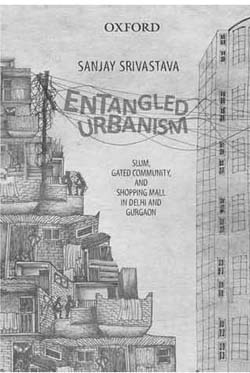India has recently been introduced to the idea of the Smart City. Exactly what shape any ‘smart city’ will take is a matter of debate. The reality of Indian cities is that they are messy, with multiple processes and phenomenon going on at the same time, several of which appear to be the exact opposite of one another. Sanjay Srivastava’s book Entangled Urbanisms: Slum, Gated Community and Shopping Mall in Delhi and Gurgaon, contends with some of these processes that are making the city what it is.
Srivastava’s starting point is the slum—he looks at Nangla Matchi, demolished since—typically populated by the very poor, who are also often migrants from different parts of the country. Disenfranchized, this populace has to rely on its cunning and ingenuity to beat a political system weighed heavily against them, in order to gain access to basic services. Two aspects are thrown into sharp relief —information networks based on locally generated understandings of power, and the use of fake documents to assert citizenship. Although regular modes of representation are pretty much out of the question in a slum, people rely on local leaders or pradhans. Who becomes a pradhan is equally fascinating—anyone who can prove that they may have some clout with the ‘higher-ups’. Even a minor association will suffice. Multiple leaders with their own loyal band of followers can exist in a single slum, creating multiple patronage networks. Loyalties, in turn, are based on which leader can get the most work done, which is further dependent on how much crucial information can be gleaned by a particular pradhan and used towards specific ends.
The clout of local leaders is ineffective in the absence of the ‘right’ documents, certifying people as residents of a specific locality/city or papers relating to property ownership, howsoever flimsy. A veritable cottage industry of the production of fake documents exists to take care of such needs, but procuring such a document is not easy either. The task once accomplished enables the lucky owner to push a foot through the door of basic service delivery, piggybacking on familiarity with the local leader. The entire process is arduous and could take years to reach a logical culmination since one must, among other things, wade through local rivalries based on religious, caste and gendered identities. The efforts may be rendered perfectly useless when slums are demolished, dispensing with both the site and the people in a single stroke to build the ‘world class city’ which aspirational middle class India wants to live in.

